10 Best Acoustic Guitars For Beginners – Recommended Instruments To Learn On!
We may also earn commissions on purchases from other retail websites.
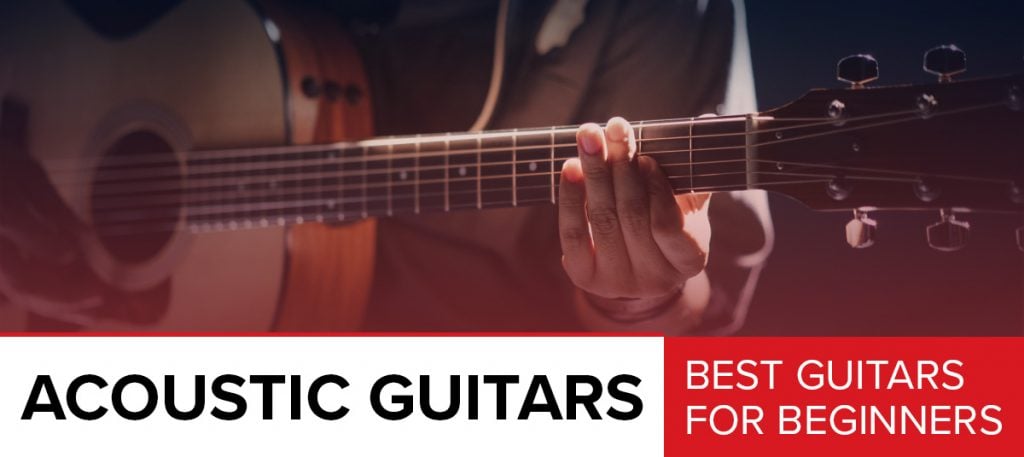
Even if you are a complete stranger when it comes to guitars, armed with dedication and the right information, you will be able to find a great instrument that will help you learn and grow into a great player.Last Updated: November 18, 2019
With a few changes in the market, we decided to refresh this important article on the best acoustics for beginners. We removed a couple of models, including the now out-of-production Yamaha APX500III, replacing it with its successor, the Yamaha APX600, and also adding the affordable Epiphone DR-100.
In this article we will be looking at some of the best acoustic guitars for beginners, highlighting our favorites in the chart below. After the chart you’ll find a handy buyer’s guide, offering you everything you need to know before you buy.
When you have your guitar, the next step will be to learn how to play! Make sure to check out our list of recommended online acoustic guitar lessons for analysis of the best courses to get you started – many of which have free trials!
Now, let’s take a look at which guitar is the best for beginners…
Top 10 Best Beginner Acoustic Guitars in 2019:
| Image | Acoustic Guitar / Rating | Summary | Check Price |
|---|---|---|---|
+ -  | Taylor Academy 12e Total of 4.80/5 | The perfect guitar for beginners? We think so! | |
+ -  | Seagull S6 Original Total of 4.88/5 | An excellent steel-string model from Seagull. | |
+ -  | Yamaha FG830 Total of 4.70/5 | A very popular model from Yamaha – real affordable quality! | |
+ - 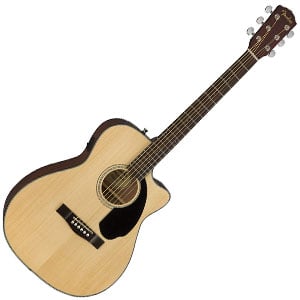 | Fender CC-60SCE Total of 4.52/5 | A versatile electro-acoustic with a top-shelf pedigree. | |
+ -  | Fender Tim Armstrong Hellcat Total of 4.77/5 | Big looks, sound and attitude from the Rancid frontman’s signature acoustic. | |
+ - 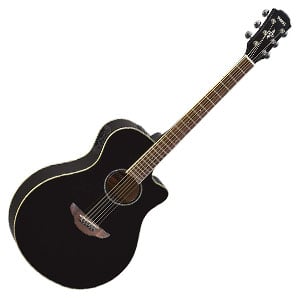 | Yamaha APX600 Total of 4.75/5 | An upgraded version of a classic Yamaha electro-acoustic. | |
+ -  | Blueridge BD-16 Total of 4.72/5 | A very good price for such an easy playing instrument. | |
+ -  | Alvarez Artist Series AD30 Total of 4.55/5 | The AD30 has plenty of style for such a good price. | |
+ -  | Epiphone DR-100 Total of 4.30/5 | A beautiful dreadnought for enjoyable practice sessions. | |
+ -  | Rogue RA-090 Total of 4.22/5 | Big value for money for players on a tight budget. |
Taylor Academy 12e
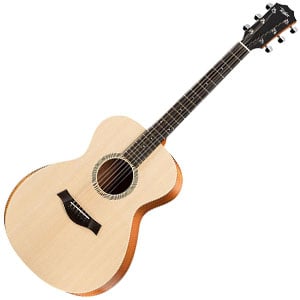
| Body And Neck: |  |
| Hardware: |  |
| Sound: |  |
| Value: |  |
Taylor’s A12e takes the words ‘entry-level’ and flips them upside down. Because, as entry-level beginners’ models go, this is more premium than the rest of the guitars on our chart.
The downside is you do pay a considerable sum for the pleasure! Still, the playability, comfort and tone on offer from is exceptional – as we highlight in the complete Taylor A12e review. It sports a Grand Concert body made from solid Sitka spruce on the top, with laminate sapele back and sides, along with a mahogany armrest for optimal ergonomics.
While electrics aren’t a necessity on beginner acoustics, we appreciate the quality of Taylor’s built in preamp, offering very simple controls and a handy built-in tuner. An exceptional choice.
Seagull S6 Original
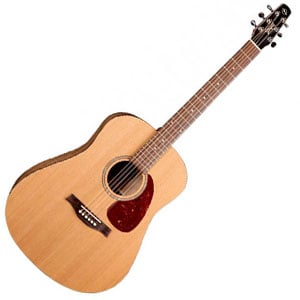
| Body And Neck: |  |
| Hardware: |  |
| Sound: |  |
| Value: |  |
The Seagull that began it all! The S6 is a popular steel-string acoustic that’s often touted as one of the best models for learning to play guitar – and we’re inclined to agree.
Crafted with quality body woods, it features a solid cedar top with a wild cherry back and produces a dynamic sound with a good mid-range that projects wonderfully. Sitting at the top is a distinctive, tapered headstock, which allows for greater tuning stability, while the hand-finished silver leaf maple neck – with rosewood fretboard – is slightly fatter than other acoustics, and is great for fingerstyle guitarists.
While the price tag may seem a little high for a beginners model, it’s a guitar that will keep you playing for years. Check out our full review of this super Seagull.
Yamaha FG830
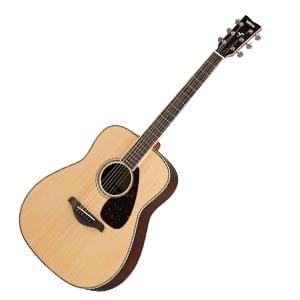
| Body And Neck: |  |
| Hardware: |  |
| Sound: |  |
| Value: |  |
Yamaha’s FG series has been around for fifty years and remains one of the best-selling acoustic to ever hit the market. So it’s no surprise that we happily recommend the FG830 to beginners looking for an attractive, comfortable and great sounding guitar at a very reasonable price.
The guitar features a naturally finished solid spruce top with rosewood back and sides, as well as a nato neck, smooth rosewood fretboard, and 20 frets. For an affordable guitar, the sound is surprisingly high-end, with excellent projection, a rich tone, and good dynamic range.
It’s comfortable to hold and very slick to play, while the advanced scalloped bracing enhances the sound quality and adds reinforcement to the soundboard. Be sure to check out our full review of the FG830.
Fender CC-60SCE

| Body And Neck: |  |
| Hardware: |  |
| Sound: |  |
| Value: |  |
Fender’s CC-60SCE is part of the California company’s new Classic Design acoustic series. This model is a handsome concert sized electro-acoustic with classic styling and timeless tones.
The solid spruce top helps achieve maximum harmonic vibration, while the smaller concert body and rolled rosewood fingerboard are comfortable to play for long sessions. The piezo pickup and Fishman preamp also let you go from an unplugged acoustic set to an amplified gig with just a cable.
The onboard equalization controls and tuner help you dial in your perfect sound right from the body of the guitar. The CC-60SCE – reviewed in full here – has a wide sonic range, with clear trebles and well-defined bass. Great for gigging musicians who want acoustic tones and electric versatility!
Fender Tim Armstrong Hellcat
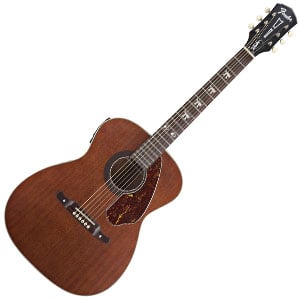
| Body And Neck: |  |
| Hardware: |  |
| Sound: |  |
| Value: |  |
If you’re looking for something a little different, you may just find it with Fender’s Tim Armstrong Hellcat – reviewed in full here. The signature guitar fuses Rancid frontman Tim Armstrong’s punk core with his acoustic roots and results in an affordable acoustic which oozes attitude.
The guitar features a naturally finished solid mahogany top, with scallop bracing, as well as mahogany back and sides. There’s a maple neck with satin-finished rosewood fretboard, decorated with a Hellcat and double-skull inlays, with Tim’s signature adorning the headstock. In short, it looks awesome!
And it sounds pretty great too, partly thanks to the Fishman Isys III pickup system with active onboard preamp and tuner, with volume, bass, middle and treble controls. Big tone, big attitude, good price.
Yamaha APX600

| Body And Neck: |  |
| Hardware: |  |
| Sound: |  |
| Value: |  |
Since 1987, Yamaha’s APX series has been a go-to collection for beginner acoustic guitarists looking for great playability, tone and the ability to plug into an amp – and the new APX600 is no different!
Although, it is... in a good way! As we highlight in the full APX600 review, this upgraded model has seen improvements in the aesthetics and build, leading to even better playability and an enhanced sound.
It still retains the aspects we loved from the earlier APX500III, such as the slim body and unique design. While electronics may not be important for the beginner, having them on this affordable model is a good excuse to practice – knowing that, one day, you may be playing it on stage!
Blueridge BD-16
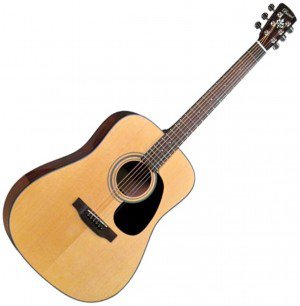
| Body And Neck: |  |
| Hardware: |  |
| Sound: |  |
| Value: |  |
If you’re on a budget and looking for your first guitar, or just something new to practice on, the Bristol BD-16 from Blueridge packs quality sound and feel into a very affordable acoustic. The guitar sports a sturdy mahogany back and neck, with a spruce top – it feels robust, but is light to hold.
It’s naturally finished and shows off good craftsmanship, while the slim mahogany neck features a smooth rosewood fretboard, and is fast and fun to play.
The mahogany and spruce combine for a bright, full-sounding guitar with excellent projection. For such a good price, the comfort and the playability on offer make the BD-16 a winner for any beginner. Check out the full review of this superb model.
Alvarez Artist Series AD30
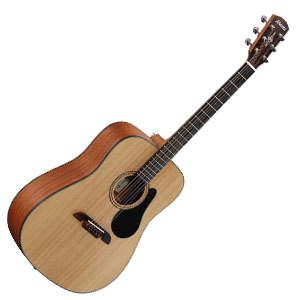
| Body And Neck: |  |
| Hardware: |  |
| Sound: |  |
| Value: |  |
Although the AD30 is the entry-level model in Alvarez’s renown Artist Series, it still offers a huge voice and superb build at excellent value. With an attractive traditional dreadnought body, the guitar is crafted with a quality solid Sitka spruce top, and mahogany back and sides.
With a dovetail joint, the mahogany neck sports a wide profile, and playing on the rosewood fretboard is a joy. As for the sound, the tonewoods – combined with the size and scalloped bracing – give an impressive projection, with a high tonal range.
At such an affordable price, this is a valuable selection for any beginner on the quest to discover their style. Make sure to read more about the AD30 in our full review.
Epiphone DR-100
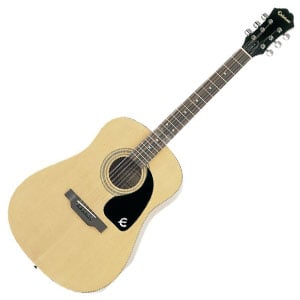
| Body And Neck: |  |
| Hardware: |  |
| Sound: |  |
| Value: |  |
The affordable Gibson subsidiary Epiphone is well known for both high-end originals and budget Gibson replicas, as well as some pretty great acoustic guitars – the wallet-friendly DR-100 being one of them.
This popular acoustic is simple but reliable in its design, featuring a dreadnought body shape with an all-laminate construction and a handsome high-gloss finish. The 20-fret mahogany neck is easy to play, featuring Epiphone’s SlimTaper profile for speed and comfort, making practice sessions enjoyable.
Even though it’s a budget choice, it still sounds pretty great, with a deep, clean and well-balanced tone, allowing beginners to hear themselves clearly. Interested? You can read more on the DR-100 in our full review.
Rogue RA-090
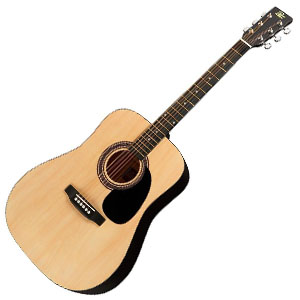
| Body And Neck: |  |
| Hardware: |  |
| Sound: |  |
| Value: |  |
On a strict budget? Not even sure if the guitar is the right instrument for you? Then the RA-090 from Rogue, with its very inexpensive price tag, will suit you perfectly.
It features all the design points you’d expect from a traditional steel-string acoustic guitar, with a nice dreadnought body shape and three finishes to choose from (natural, sunburst, and black). The body is made from whitewood, while the nato neck is home to a painted maple fretboard with 20 frets.
Nothing premium about this guitar, but together the woods and build quality provide a decent sound with good projection and clarity, that allows any beginner to start playing with confidence. Make sure to read our full review of the Rogue RA-090.
The Acoustic Guitar Buying Guide for Beginners
While it’s hard to resist jumping straight in and buying the first acoustic guitar you see, it’s crucial to think long-term when making your choice.
As a beginner, you will want something that first and foremost feels comfortable and fun to play, sounds good and will hold its tuning reasonably well. It doesn’t necessarily have to be an expensive guitar, although you will find significant differences between a guitar in the $100 region and one nearer $400.
Unless you aren’t sure that playing guitar is for you, don’t make a short term investment with your first purchase – take into consideration the fact that a quality beginner guitar can grow with you as you become more experienced. The majority of guitars we’ve highlighted above would please an experienced player as much as a beginner.
After all, you may not know how long it will take to learn guitar, so you want something well-built to last you a while.
Solid or Laminate Top?
There’s a difference between the two and, as you may have guessed, a solid wood option – like you’d find mentioned in our Taylor A12e review – is better at providing more resonance and greater depth in tone.
However, even lesser tonewoods or laminated tops, when combined with good craftsmanship, can still provide excellent sound quality. So if you are just starting out, there’s no need to worry too much about whether a top is solid or laminated. Go with the guitar that suits your needs and fits your budget.
Steel or Nylon Strings?
There’s a common belief that certain strings are better for beginners than others. While nylon strings can be easier on beginner's fingers, the main thing that matters when it comes to guitar strings is the style of music you are planning to play, because the difference in feel and sound between the two materials is significant – even for a beginner.
Nylon strings are essential for any classical instrument, and if you are planning to play classical music or Latin styles such as flamenco, a nylon string guitar is the way to go. Steel strings are more appropriate for rock, pop, blues, and pretty much everything else that doesn’t fall under the classic umbrella. You can check out our article on the best classical guitars for beginners.
Remember that if you are looking towards eventually performing and recording with your new acoustic, you’ll want to get hold of either a nylon or steel string guitar with electronics to give you the ability to plug into an amp.
A word of general advice – never use steel strings on a classical guitar, as the high-tension strings will damage the instrument. You have been warned!
What is The Easiest Type of Acoustic Guitar to Play?
There are several different popular acoustic guitar shapes, most of which will be pretty easy for a beginner to get to grips with. Most of the respectable acoustic guitar brands have a plethora of beginner friendly solutions.
However, we suggest avoiding a Jumbo acoustic, which is a popular style with country players. This style of guitar is very big and bulky, and ultimately adds an extra consideration that beginners just don’t need.
For somebody just starting out, it would be easier to learn on a dreadnought or an orchestra model, or – if you are particularly small – a parlor guitar.
Whichever acoustic you end up purchasing, the setup and strings play as big a part in the overall playability of the guitar. Technically, you could spend $1,000 on a beautiful acoustic, but if the action is too high and the strings are rusty, then you will struggle to play smoothly.
The solution is to get your guitar properly set up after purchasing. This is easy to do yourself if you have a spare 30 minutes and can follow simple YouTube videos such as this one:
How Much Should I Pay for a Beginner Acoustic Guitar?
It’s a good question, although one with no definitive answer. Ultimately, learning on a $5,000 Martin would probably be very beneficial due to the quality, tone and playability of such a premium instrument – but this is probably overkill, considering most experienced guitarists don’t even have one of these!
The best advice we can give you is to look at your aspirations and enthusiasm. Do you really have your heart set on learning how to play the guitar? If so, then it would be wise to invest at least $100 to $200 on an affordable acoustic that looks, feels and sounds better than an entry-level budget model.
Buying the highest quality guitar you can afford will encourage you to practice and will feel more comfortable to hold and play.
With this in mind, if you are going to dedicate your life to playing the guitar (and you have the budget), then spending up to $500 on a good mid-range model – something like an entry-level Taylor – certainly won’t harm and will be an instrument that will stay with you for a long time.
What to Avoid When Buying an Acoustic Guitar?
There are a couple of important things to look out for when buying an acoustic guitar for the first time, one of which being plastic hardware – especially if it’s used on the bridge or the tuning pegs. Unless you are paying less than a hundred dollars for the instrument, there’s no reason why a good beginner guitar should have a plastic bridge or saddles, which aren’t particularly durable and do nothing for the instrument’s tone or sustain.
If you are on a very strict budget and need something low cost to get started, check out the Jasmine S35 review, which proves a magnificent pick for beginners.
We’ve covered just a few aspects of what to look out for when shopping around. However, there are hundreds of online videos that offer good advice on choosing and buying an electric guitar, including this one.
Elsewhere, The Acoustic Letter is a very helpful YouTube channel run by professionals that enjoy what they are doing. Here’s a useful video from these guys:
Do You Need an Amplifier with an Acoustic-Electric Guitar?
If you are just starting out and have purchased an acoustic-electric (better known as an ‘electro-acoustic’) guitar, you may be wondering whether it will work without an amp.
The good news is that you do not need an amplifier to hear the guitar. Without being plugged in, an electro-acoustic works just like a regular acoustic guitar. In fact, you never have to plug in an electro-acoustic if you don’t want.
However, manufacturers charge extra for adding electronics (in the form of pickups and preamps) to their acoustics, so to buy one and never plug it in would be a waste of money. A small acoustic amplifier would work well if you just want to practice with others, although you would need something bigger for performances.
If you are still deciding whether or not to purchase an electro-acoustic, we recommend you stick with a regular acoustic if you are a complete beginner. The reason being that, as a beginner, you don’t really need to amplify your performances, as you won’t be performing much until after a few months of solid practice.
Are You Buying an Acoustic for a Child?
Bear in mind that a full-sized acoustic will not be the best guitar for children – unless they do some quick growing!
Thankfully there are different sized guitars that suit all ages. As a general rule, a ¼ size guitar will suit anything from the ages of 2 to 5, a ½ size guitar is good for 5 to 8 year-olds, while a ¾ guitar will suit those from ages 8 to around 12. However, if you can get your child to try a few, you’ll be able to see the best fit for them.
The Final Word
Buying an acoustic guitar is a great experience and one that could prove to be life changing! So when looking to purchase your first one, take your time. Watch plenty of videos, read our articles, and speak with experienced guitarists, before making your final selection.
Passion is a vital factor, especially for beginners, and hating your musical instrument from day one will not get you very far in the long, occasionally frustrating journey you are about to begin. If you feel unsure about a model, just skip it and move on to the next one. You’ll soon find something that fits.
When you have your guitar, the fun of learning the instrument can start. Make sure to check out our page for how to start learning guitar online for lesson reviews and tips. Good luck and happy shopping!



George A. Marlow says
I purchased a Dean Performer Plus -acoustic/electric with cutaway; the top is sitka spruce and the back & sides are mahogany;the fretboard & bridge are rosewood, the saddle is bone, the nut is tusq… now I am not saying this guitar sounds like my Martin – BUT – it does sound awfully good. I would highly recommend this for beginners & intermediates. The action on the neck is extremely good for a low budget guitar. They list for under $400. If you get a chance check one out… see how it matches up against your list of guitars. I hope this was helpful- especially for the beginners. Sincerely > George M.
Gabriele says
Hey,
I would like to hear your opinion about Stagg guitars, please? 🙂
I want to get a guitar (never had one). Thinking about an acoustic guitar, but I don’t know anything about Stagg (is it good brand or bad). Also these guitars aren’t the cheapest.
One guitar catched my eye: Stagg SA30D
Thank you
Ananth says
Hi
Thank you for the information.
I am as a beginner looking for Yamaha FG800 and Yamaha FS800.Can you please tell me the difference and can you tell which is the superior in these two.
I know FS800 is having small body. Does it alter the sound of the guitar?
Wajahat says
How about Jasmine S35 ??
Is it good for beginners??
Chris says
Yeah that’s a good one! It’s very affordable and plays well. You don’t want to spend too much as a beginner, unless you can really afford it.
Elsa DeMars says
I was wondering, what is the difference of sound quality on a acoustic and acoustic electric guitar?
Chris says
If they are both made of the same woods, the same brand and the same strings, there won’t be any difference between an acoustic and an electro-acoustic in terms of quality – they should sound identical unplugged. The electronics only affect the guitar when plugged in. Hope that kind of answers your question!
Jacob Burks says
I have larger fingers and am struggling with my Fender as the neck is pretty narrow causing the strings to be bunched closer together. It’s difficult to stay on one string as a result. I see a couple above mention wider necks. Is there a comparison chart for them so I can try something else?
Katina Drummond says
I am looking for a guitar that is easy to chord for petite hands.. I have my dad’s Alvarez and love it but struggle terribly to chord f which according to my dad should be easy…
Bob Parker says
What is your opinion of Jasmine acoustic guitars?
Stephanie Gonzalez says
Hello!
I am currently doing my research on what guitar to buy to start back on it again. What do you think of the Ibanez brand? I am specifically looking at the AW54CE-OPN AEG to buy but I do not know much of Ibanez. I would like your opinion on it. TIA!
Chris says
Ibanez is a great brand for both electric and acoustic guitars. They do some good budget models as well as some high-end guitars. Worth checking out!
fich66 says
Have you checked out the Tanglewood Crossroads series, the Dreadnought and the Orchestra come in at £99!
I’ve been playing guitar for some time now, picked one of these up just to see what they have achieved in this price range. I have to say more than impressed.
Chris says
Good call! Tangelwood made my first electro-acoustic and I couldn’t put it down. I’ll take a look at the Crossroads series, cheers!
Jerry says
Which is the Lowest string action Fender Elec/acoustic guitar for beginners
Chris says
Is there a specific reason you chose the Taylor a12e for this list and not the 10e? Im looking to buy my first guitar and I cant decide which to go with.
Chris C says
That whole series is great – maybe a little expensive, but it’s something a beginner would be very lucky to have. My first guitar was $30 and absolutely awful!
Wayne Masoka says
Hi Chris, be best if you find a guitar store and try them before ordering. The 10E is a dreadnought and has a bigger body. If you are a good size adult may be ok. The 12E is a Grand Concert body . You can go on line at Taylor and see them. But be best you you try them. Good Luck and Enjoy.
Vikas says
I am looking for a begineers guitar and after many researchs I have come to conclusion in buying Fender CD60S. Please suggest me.
Chris says
That’s a good affordable model, especially as it is compact – makes chord shapes easier to reach when you are just starting out!
Roderick Llewellyn says
Useful article! It would be helpful if you showed which ones are available in left-handed models for us lefties !